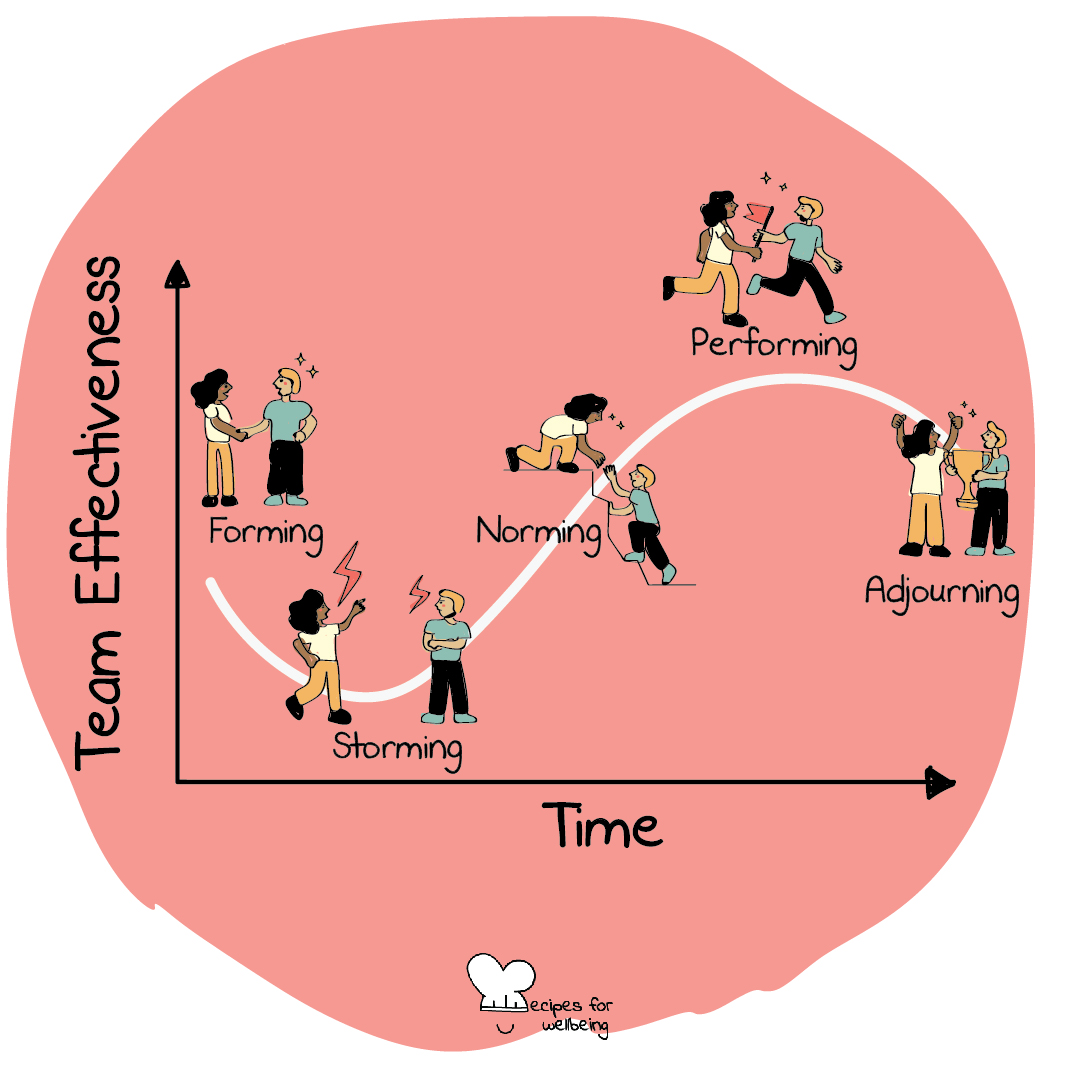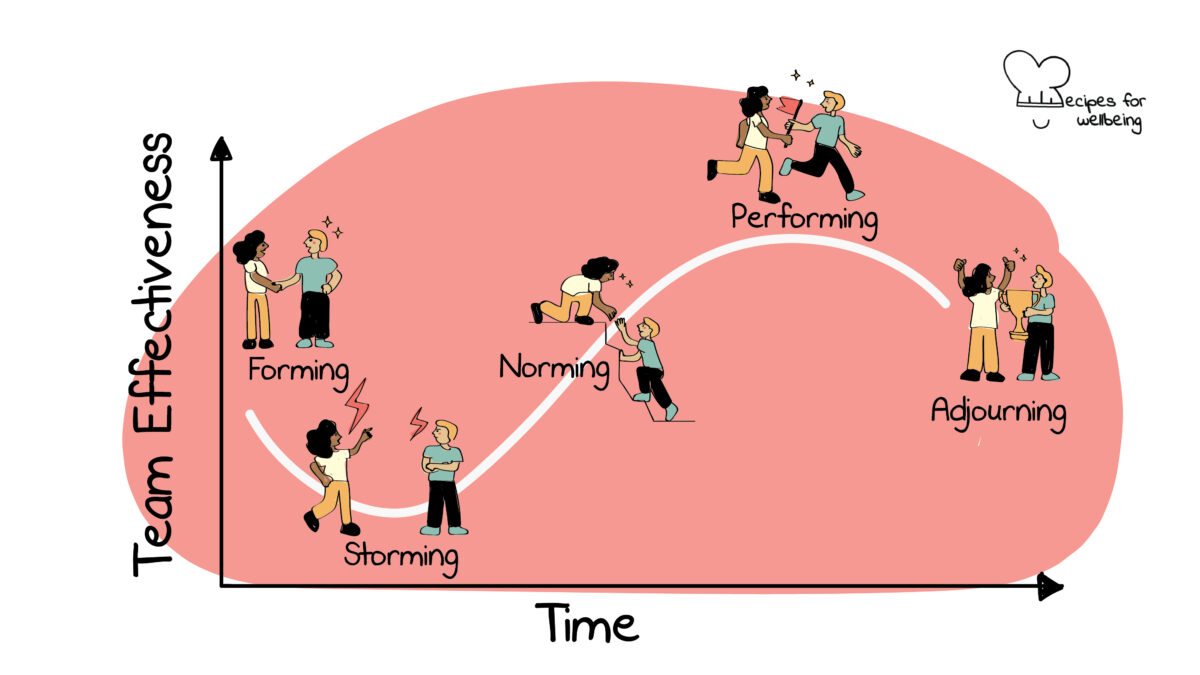
5 stages of team development
Human accomplishments result from the reciprocal influences of external circumstances, a host of personal determinants, including endowed potentialities, acquired competencies, reflective thought, and a high level of self initiative. ―Bruce Tuckman
👥 Serves: 11-25 people, 2-10 people, 26-40 people, 41+ people
🎚 Difficulty: Medium
⏳ Total time: Ongoing
🥣 Ingredients: Your team
🤓 Wholebeing Domains: Accomplishments, Community, Discomfortability, Liberatory Learning, Radical Care
💪 Wholebeing Skills: Agility, Ambition, Conflict transformation, Discernment, Emotional intelligence, Feedback, Flexibility, Holding space, Stress management

5 stages of team development
📝 Description
Understanding the internal characteristics influencing the performance of your team.
What makes teamwork effective? Oftentimes we focus on external characteristics (e.g. having an adequate budget to carry out the project), but we forget that internal characteristics (i.e. the people in the team and how they interact with each other) also play a key role. When team members are assigned to a new project, it is helpful for them to get to know each other, to clarify their expectations, to assign tasks and responsibilities, and to coordinate their work. This process turns a group of individuals into a team.
Educational psychologist Bruce Tuckman identified a five-stage development process that helps teams perform effectively. This recipe guides you through the five stages of forming, storming, norming, performing, and adjourning. Please note that these stages are not linear and a team can move back and forth multiple times, which is why it is important to have check-points to assess where a team is and what their needs are. Finally, you should also consider what norms are emerging in your team because the level of conformity to norms determines the level of cohesiveness in your team. High cohesiveness teams are also high performing.
👣 Steps
Step 1 – Forming
The forming stage happens when a team is newly formed and team members are trying to get acquainted with each other. You might observe a sense of excitement and anticipation in some members, and fear and anxiety in others. Because team members want to be accepted in the group, you might also notice a tendency to be polite and avoid conflict. Team members will ask questions such as: “What is expected of me?” or “What do other team members offer me?” or “Will I fit in this team?” etc.
This stage is marked by high levels of uncertainty and ambiguity. The team seeks leadership and authority to clarify its mission and vision, establish specific objectives and tasks, identify roles and responsibilities, and establish team rules and processes. To advance from the forming stage, team members need to leave their comfort zone of non-threatening topics and risk the possibility of conflict.
Step 2 – Storming
The storming stage is – like its name suggests – tough to pass through. As team members get to know each other, personalities start to emerge. This stage is marked by conflict and competition because team members may disagree on the project goals or may have formed cliques around strong personalities. You may observe defensiveness and resistance among team members or an increase in tension and jealousy. As a result, team performance may decrease in this stage because team members are spending a lot of energy into unproductive activities.
To move through this stage, it is helpful to focus on inter and intrapersonal relationships, encouraging active listening to learn to accept individual differences and work through conflicting ideas on team tasks and goals. It also helps to clarify and understand the team’s purpose, re-establish ground rules and norms, and identify processes to deal with breaches of conduct and emerging tensions. During the forming and storming stages, team norms focus on expectations for attendance and commitment.
Step 3 – Norming
Once the team gets through the storming phase by resolving its conflicts, it enters the norming stage, which is marked by an increased sense of unity and shared leadership. There is more clarity around leadership roles, as well as individual team members’ roles and responsibilities, which increases the sense of belonging to the team as well as trust in each other. As the team focuses on shared goals and objectives, it also starts to resolve interpersonal differences and problem-solving is more effective. This increased sense of cohesion can boost team performance.
However, remember that the harmony is precarious and if disagreements are not managed effectively, the team can slide back into the storming phase. Also, during the norming stage, team members may begin to fear the future (which may include the dismantling of the team itself), so you might notice an increased resistance to change.
Step 4 – Performing
As the team matures by following clear goals, stable structures, and solid commitments, it enters the performing stage. This phase is marked by high levels of performance because the team is well-organised and well-functioning. Trust in one another, autonomy in one’s roles and responsibilities, flexibility in carrying out one’s tasks, etc. all contribute to a general sense of satisfaction and high levels of effectiveness.
This does not mean that conflicts do not emerge, but that they are dealt with constructively through feedback and dialogue. During the norming and performing stages, team norms focus on relationships and levels of performance.
Step 5 – Adjourning
As the project comes to a close, the team enters the adjourning stage, which is focused on wrapping up the final tasks, documenting the results, and reflecting on the process. You might observe signs of grief or sadness (or a sense of relief that the project is almost done!) and it is very important to make space for acknowledging the work done, celebrating the goals achieved, and reflecting on how the collaboration went to bring closure to the project and allow the team to move on to other projects.

